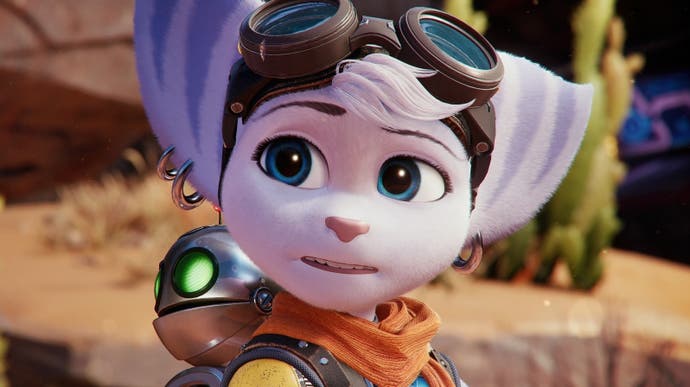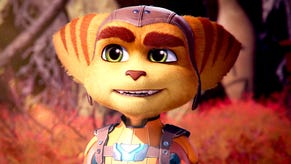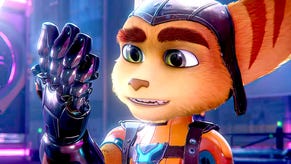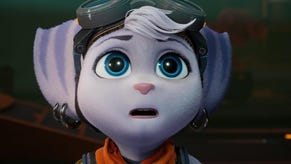Ratchet & Clank: Rift Apart: a PS5 stress-test built from charm
Riveting.
Back in 2012, and powered by the Quake engine, Thirty Flights of Loving unleashed a stylish trick on its players. Jump cuts. Oh boy, how we all sat up and put down our Cahiers du Cinéma. How we briefly silenced the gentle putter of our artisan zoetropes. Imagine it: you're running down a corridor and then the world cuts around you and you're somewhere else. Magic. A particular smart kind of magic that made you feel like you were in on something just by witnessing it, just by seeing it for what it is.
Jump cuts are still pretty powerful when used in a film - I don't fully get them, actually: they manage to make things feel more real, like a documentary, while also drawing attention to how artificial everything is? So in a videogame, in Thirty Flights, they were electric. Thirty Flights used jump cuts for bursts of Zippo-flicker new-wave cool. Breezy ambiguity! What is truth, eh? Eh? Some of us never really got over this, to be honest.
Ratchet & Clank: Rift Apart has a similar sort of trick, but the handling - and the tech behind it - is completely different. We are a long way from the Quake engine with this one, so to put it in the language of hardware, what came first, the SSD or dimensional rifts? When asked this at a recent virtual junket - bear in mind when watching the pretty much astonishing videos of this game in motion that much of what you see has been made in people's kitchens and spare bedrooms during the pandemic - the team at Insomniac finds it hard to answer the question. But here are the basics: PS5's SSD is a beast at loading, so while that's bad if you like to make a Pop-Tart between levels - I am not here to judge - it means that you can jump right into a game from the off. And game developers, after really thinking about it, have realised that you can jump right into a game inside a game. And what if both games are the same game? Hold me.
This means that in the joyous soft-play cosmos of the latest Ratchet & Clank you can now hop between space and between dimensions, disappearing through a splinter of golden light and turning up somewhere entirely new. Nice handling - the rifts have their own audio signatures and their own patterns of haptic feedback so you can hear them and feel them as well as see them approaching - but the high-level take is very simple. If Thirty Flights was Truffaut examining the sharp and smoky edges of memory over an espresso, Rift Apart is that bit in a Bourne film where Matt Damon parkours through someone's living room trailing beaded curtains and incense. Did that just happen?!
Actually that's not quite it. It's older. It's more like the bit in a silent comedy where the careering jalopy leaves the dusty road on a sharp bend and travels through a barn, emerging from the other side with a goose in the driver's seat.
So you're riding the rails. Happily Ratcheting as always. You're racing along through a bustling sci-fi city and things are erupting and buildings are falling. Maybe there's wise-cracking? Then a rift appears and you're suddenly in a very different city, lashed by bright neon against dark towers. Boof! Another rift appears and you're back in the daylight but the rail is gone and you're sliding down the squeaking canted surface of a mega-scraper. Oh, the polymers! You fall and the sidewalk looms. And a rift appears. You're moving between dimensions, which means the game is moving between levels, presenting them both simultaneously and allowing you to cross from one to the other and back again. Jeepers. This is loading taken to the max, folded in on itself. It's SSD stuff tied in manifold knots.
It is seriously fancy, and yet that thing about the silent comedy - the sheer pelt and invention of those old films - might actually make sense of it. There's something warmingly old fashioned about Ratchet & Clank, despite the fact that this one is pushing the PS5 until its dinky little pronged collars wilt. Ratchet is 'fifties utopianism, a nuclear picnic, the Magic Highway, the Jetsons and a bit of Mad magazine. But it's also pure screwball. The developers are happy to talk about how Ratchet's fur now clumps when wet and how Clank has proper stretched reflections on his stainless steel body, but they also openly admit that really the series is built around humour and heart. Rift Apart is designed to show off the PS5, yet the creative team are still leading everything: they pick and choose and assign priority. I was fascinated and quietly thrilled to learn that the question the studio still asks itself when weighing up a new feature is: is this charming? Bit of the old armchair to that.
Insomniac often talks about the importance of iteration, and according to Rift Apart's creative director Marcus Smith, that's where a fleeting subatomic particle like charm is often found. "It's that moment of where you see a character behaving the way you don't expect. For example, we have writers who have never written for the franchise before, when they first started writing dialogue, Clank would sometimes come off as kind of a jerk, kind of abrasive. Instead of being analytical and charming, he was a little know-it-all you didn't want to hang out with. Or when an animation came back that looked too stiff. Little nuance things. Art directors will look at marketing materials and spot things that people like me don't even see. 'That pixel right there is all the difference between, I want to hug it, and, I don't care, it's just a piece of plastic or something.'
"It's staying true to the characters as they were developed," he continues. "Luckily we have nearly twenty years of experience. If you go back to those older games you'll see that Ratchet and Clank weren't originally charming? it was something that had to be developed a little bit. If you go back to the first game especially, it can be a little abrasive. I think their characters fell into place a little bit more and were defined during the PS3 Future series. And that's what it comes down to, we have a large number of team members all of whom love this franchise. And if there's any little edge that's sticking up from anybody's expertise, we'll hear about it.
"And that's really where the charm police come in. Somebody will say, 'Mmm, that doesn't sound right. It rubs me a little wrong and I'm not even sure why.' That will be enough for us to go back and look at it."
Rift Apart begins on Megalopolis on a day of celebration for Ratchet and Clank. This means Thanksgiving's style parade floats and huge balloon figures of major characters in the story. But it also means a gift from Clank - a repaired doodad that will allow Ratchet to travel to another dimension where he will no longer be the last Lombax in existence. A dimension where he can find out about himself.
Steady on. This also means that Dr Nefarious turns up, ruining the parade - creating an ideal tutorial for anybody who's forgotten how to crouch - and stealing the device. A rift is opened to a dark new dimension. Ratchet and Clank are separated, spilling into another universe in which Megalopolis is now Nefarious City. This is a universe in which Nefarious always wins. Will our heroes reunite and stitch the omniverse back together?
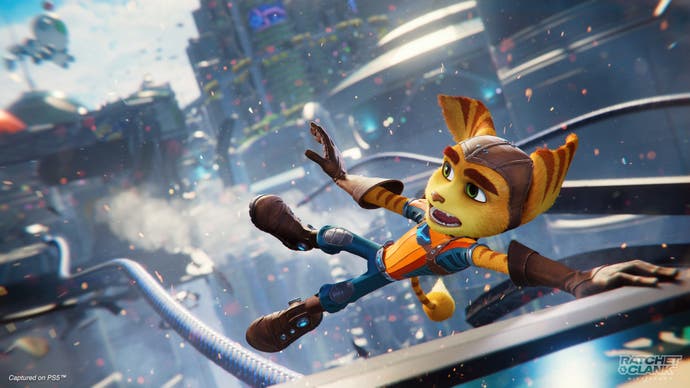
It's a wonderfully economical set-up in story terms, and this works well with a delivery that is typically maximalist. One of the focuses of Rift Apart is increased traversal options - chaining dashes (dimension-shredding dashes with a bit of invulnerability threaded in), wall-runs and bounceables in a way that's pure Sunset Overdrive. And what better way to start to put some of this together than by hopping between huge cartoon animal balloons, landing on parade floats that are really little islands, learning the groove of Ratchet again, a groove that takes you between exploration and tight little combat encounters enlivened by over-the-top weaponry, with story gumming everything together.
The density is upped, the number of moving elements and colourful features and creatures with primary and secondary animation, all somehow chucked in with no loss of readability. But what's fascinating to me is watching how Rift Apart handles what comes next. How should a game as cheery as Ratchet & Clank take on the classic cyberpunk city?
The answer is that someone repeatedly asked themselves, well, what would be charming? You need darkness and neon and the sense of being walled in by superscrapers. But can we have that with a little business on top? Can we have baddies who look like 'fifties UFO-mania aliens and saucers? Can we have oppressive dystopian dance clubs in which everyone gets down to truly miserable beats? Can someone please put something amusing on the mega-signs on the mega-towers?

This darker dimension is home to new cast members and old ones revisited. To put it another way, it's home to a familiar group of characters, but characters who have grown up in a much more horrible universe. Here was a serious choice, in other words, and at one point Insomniac had decided that the mirror universe crew should simply be polar opposites of their more family counterparts. Happily, the line they eventually landed on is far more nuanced - and far more promising from a story perspective. The characters remain true to themselves but are also the result of a cosmic coin-flip. So Skid McMarks is now a hacker called Phantom, fighting the Nefarious regime. Rusty Pete is still a pirate, but now he's French. Zut alors.
At the centre of this is Rivet, the Ratchet of the alternate dimension. And a major player in this game. Ratchet's still out there in his own levels, older than before but still impetuous, still a spiritual eight-year-old in terms of the beautifully-observed animation that channels emotions through the slump of shoulders or the sudden widening of eyes. But Clank, meanwhile, has ended up with Rivet. And Rivet is something Insomniac is really proud of.
Rivet's a silver lombax with a bouncing silver quiff and the voice of Jennifer Hale. She has a prosthetic arm, which hints at a deeper theme of the story - "All of our characters are capable despite the obstacles they face and we want our players to feel that way too," says senior animator Lindsay Thompson - and the crucial thing about Rivet is that she's a new character with her own personality and a lot of history in this much darker dimension. She may have Clank for a lot of the game, but her story has been shaped by his absence in the past - in this world she grew up alone. She's tough, wielding a hammer rather than a wrench, and she's wonderfully resourceful and decisive, but Insomniac admits that the key to working her out was to define what she is not. She's not cynical or cruel. (Clank, incidentally, will still have his own puzzle levels, which look to me a bit like a sort of Holodeck spin on Lemmings, but that stuff is largely unrevealed at present.)
Whoever you're playing as while the story pings from one lead to another, the dimensional rifts go deep, to steal a phrase from Emilia Clarke in that extremely strange ad about skincare that's running at the moment. There's more of an emphasis on each planet in this game, each with its own story, and some planets are built around different versions of the same world, in a way that calls to mind the peerless entropy-shredding of Titanfall 2's Effect and Cause level. In a way, it's solid gold screwball sitcom stuff, too: the classics but with a twist, the same but different. A couple of planets provide altered versions of favourite locations from the old games. There's Sargasso with its acid swamps and dinosaurs set amongst bowed trees and backed with misty dawn light. It's Jurassic Park by way of Claude Lorrain.
At points the game will tinker with open-world design. Insomniac's excited about one planet in which the objectives can be completed in any order you want and you're invited to stay as long as you fancy, barreling around a biosphere that's been designed with a skate park in mind. It sounds wonderful, and another reminder that Smith came to Ratchet off the back of the glorious Sunset Overdrive. But that planet will have to wait for now. Following a quick trip to Nefarious City, we're shown another level, Tarron IV, a junk planet with a fairly clear, if broad, path through the quests.

Let's stop for a second here to talk about weapons. The reason I'm stopping here is because, as I watched Tarron IV unfold, I really wished the Looney Tunes pace of the game would slow for just a second so I could see the weapon wheel whenever it appeared on screen. That greedy weapon wheel! Ratchet & Clank delivers so much of its character through its arsenal. It's a means of creating expressiveness and - yes - charm. Rift Apart sees a few old favourites returning, but also has some new delights in store. Let's take a look.
Insomniac has three criteria for weapons - they have to be spectacular, or strategic, or humorous and unique. Okay that's four. Ideally they're all of these things. Alongside the crucial new Rift Tether, which allows players to attach themselves to rifts, pull them open and even move them around, we've got Shatter Bomb grenades, that do exactly what you imagine they do, and the Negatron Collider, a sweeper of a weapon that charges a big beam of energy you can then blast across the battlefield.
The Ricochet, meanwhile, is inspired by pinball. It's a metal ball that pops up next to an enemy. Pull the trigger again and again and you can bounce it off the enemy's head. Time it right and you get a bonus. And you can do all of this while ducking behind cover and having a smoothie.
Onwards! The Void Repulsor is a bubble-gum pink laser shield that you can charge and then chuck at people for a knockback, while the Topiary Sprinkler, possibly my favourite, immobilises enemies in beautiful foliage. Look closely - the gadget has a green thumb. I will be honest: my notes disintegrate at this point. Mr Fungi? Drill Hound? Maybe I've been hit by the Ricochet myself. But in many cases as great as these weapons sound, there's much more to them.
"The controller is a game-changer," Smith says. "I joked that it felt like they'd designed the controller specifically for Ratchet & Clank's arsenal." So take the Enforcer, a double-barreled shotgun. Using the adaptive trigger you can now choose to fire one or two barrels depending on how hard you push through the resistance. Crowd control or DPS on a single trigger.
And the Enforcer is not alone. The adaptive trigger allows you to charge and then fire the Negatron Collider, while the Hover Boots return and use the trigger to let you build up speed with kicks, a la rollerblades.
It's not just the controller doing stuff, though. Ammo bars have now been added to reticules, more chunks come off enemies under fire, and each weapon now has camera shake and recoil, while improved depth-of-field effects pop your target from the background.
Tarron IV is a chance to see all of this in play at once. The planet's a sort of South-West vista of rocks and canyons, but absolutely piled with scrap and doodads and the kind of detailing that Insomniac handles with such brisk flair. Rivet and Clank have come here to get a gadget of theirs fixed by a local legend called the Fixer, but the path to the Fixer itself needs fixing, and they'll first need to collect another gadget called a Hurlshot in order to reach him.
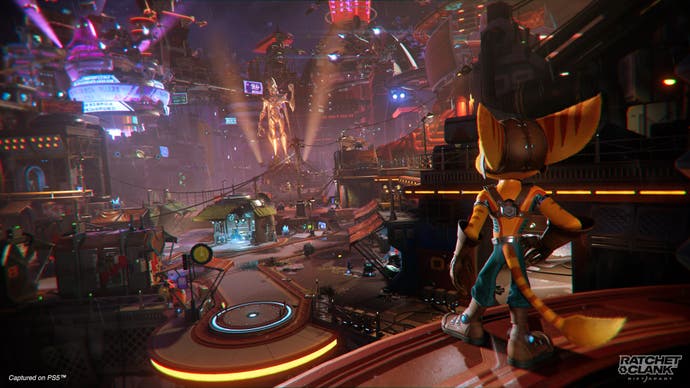
In between them and the Hurlshot are pirates, which means we move from shooting low-level frog-type stuff to taking on a junky armada of floating ships and near endless robotic yo-ho grunts. Moving from canyon and mini-arena to the decks of the ships, the arsenal shines, the Topiary Sprinkler immobilising so the wide beam of the Negatron Collider can eviscerate, the switch between Shatter Bombs from a distance and the Enforcer up-close bringing back fleeting memories of the first Halo.
Mixed in with this is traversal - a new language of wall-runs and those magical dashes - which only grows in expressive potential once the Hurlshot arrived. It turns out to be a device that allows you to grapel to a point and then spin to build up speed before chucking yourself into the distance.
Mini-bosses like "Wee" Roger - not Wee at all - and "Not so Wee" Roger keep the game moving, and I'm sure I briefly glimpse the Pixelator, a returning favourite whose next-gen makeover shifts it from 8- to 16-bits (of course) and renders every pixel as a perfect ray-tracing cube. The Lightning Rod weapon sparks between enemies like a lightning weapon in any other game, but it also shudders everyone's chops and turns them into a hilarious Muppet chorus.
Eventually we reach the Fixer, and now he needs fixing too - he's turned a bit glum and evil, and he's also the size of an ocean liner on end, slumped in a towering gantry that he pulls himself out of just to attack us in a final boss fight. Bats erupt from their perches on rails as we grind around, robot arms dismantle paths and create new ones, and we even see a new use of rifts - local rifts, I guess you'd call them, which pop up and allow you to hypertext your way around a single environment. Strafing by tangling dimensions! I think this is the promise of Bioshock Infinite, finally delivered in a game about funny rodents. (Is Ratchet a rodent? Is Rivet?)

Before we're out, the rifts have a final trick. With the Fixer dealt with, we visit a Pocket Dimension, an entire purple world tucked away through a crack in the universe. Pocket Dimensions feel a bit like the Shrines in Zelda - areas in which the developers go deep on a single gadget or gimmick, with your reward a neat piece of armour. This one offers coral and a beetle-ride of great speed and clumsiness and we get a helmet out of it. (The armour system, incidentally, is extremely flexible. Just by owning the piece of armour you get its stat boost, I gather, so you can then wear whatever you want.)
All this, and made from people's kitchens and living rooms? Will this forever be the pandemic Insomniac game? "I'm trying to remember where we were when we all had to leave and come home," Smith says. "But you know it is a story that centres around friendship, Ratchet and Clank are friends, and there is something there about being separated at the beginning of the game and longingly looking for each other that probably we all related to."
There's more, though. For the first time the Insomniac team was making a game for families in the midst of their own homes - and I wonder if that subtly changed the DNA of the game. "My daughter's eleven and she was a paid usability tester at one point," laughs Smith before we clock off. "She made it all the way through and gave her feedback. That was honestly when I knew we had something special."
He pauses. "I understand when it's us game developers and we play the game and we laugh at certain moments, but to see an eleven-year-old who frankly has an eye-roll that's nearly audible, eleven going on sixteen, to see her laughing at all the jokes that we wanted to hit? That was incredibly special. I will always remember the development of this game as the one my daughter participated in."
